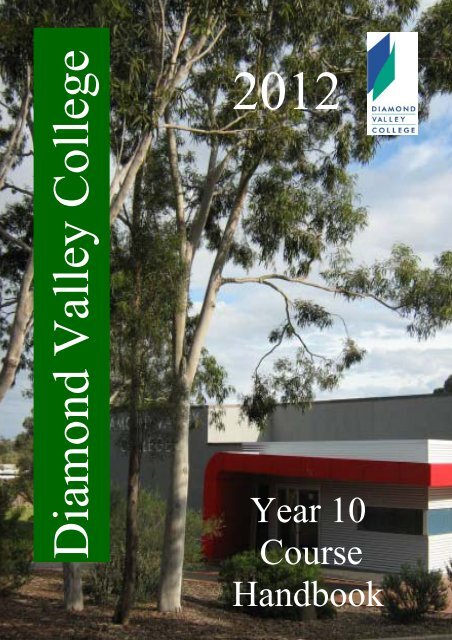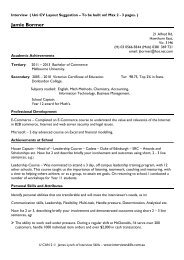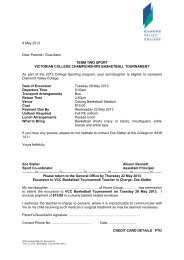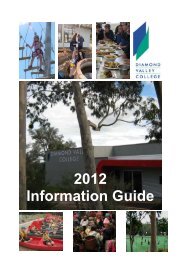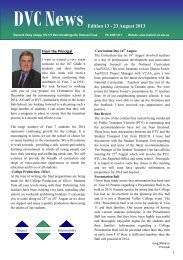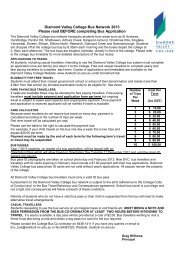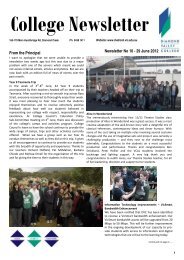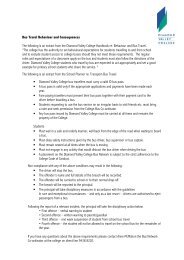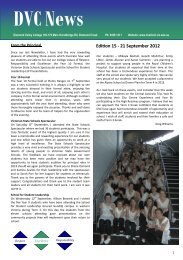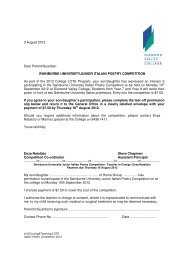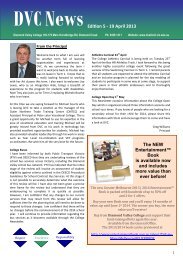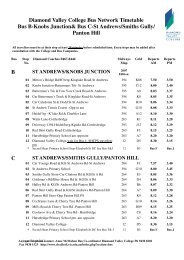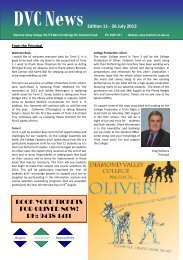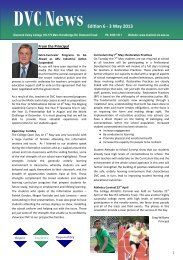Year 10 Course Handbook - Diamond Valley College
Year 10 Course Handbook - Diamond Valley College
Year 10 Course Handbook - Diamond Valley College
- No tags were found...
Create successful ePaper yourself
Turn your PDF publications into a flip-book with our unique Google optimized e-Paper software.
2012<strong>Year</strong> <strong>10</strong><strong>Course</strong><strong>Handbook</strong>
2012 <strong>Diamond</strong> <strong>Valley</strong> <strong>College</strong> <strong>Year</strong> <strong>10</strong> <strong>Course</strong> <strong>Handbook</strong> 2
Table of ContentsAcknowledgements ........................................................................................................ 4Introduction .................................................................................................................... 5The Senior Sub School Team 2011 ....................................................................... 5Expectations of Students ................................................................................................ 6Introduction ............................................................................................................ 6General Information ............................................................................................... 6<strong>Year</strong> <strong>10</strong> Program .................................................................................................... 7Program requirements: ................................................................................................... 7Confirming your course: ................................................................................................ 7Enhancement Studies-Advanced Placements ................................................................ 8Compulsory Units .......................................................................................................... 9English-EN<strong>10</strong> ......................................................................................................... 9Mathematics-MA<strong>10</strong> ............................................................................................... 9VCE MATHEMATICS PATHWAYS .................................................................... <strong>10</strong>MATHEMATICS PATHWAYS ............................................................................. <strong>10</strong>Art -Key Learning Area ............................................................................................... 11Art-AR<strong>10</strong> ............................................................................................................. 11Design Methods And Techniques-DEMT ........................................................... 12Digital Art-DA<strong>10</strong> ................................................................................................. 12Performing Arts ........................................................................................................... 13Dance-DANC ....................................................................................................... 13Drama: From Page to Stage-DRPS ...................................................................... 13Music-MU<strong>10</strong> ........................................................................................................ 14English-Key Learning Area ......................................................................................... 15English: Creative Writing-ENCW Semester One ................................................ 15English: Writing for Publication-ENWP Semester Two ..................................... 15English-Key Learning Area ......................................................................................... 16English: Media Issues-ENMI Semester One ...................................................... 16English: Advertising Issues & Analysis –ENIA Semester Two .......................... 16Health & Physical Education-Key Learning Area ....................................................... 17Fitness and the Heart-PEFI .................................................................................. 17Physical Education-PE<strong>10</strong> ..................................................................................... 18Team Sports-PETS ............................................................................................... 18Humanities - Key Learning Area ................................................................................. 19Humanities: Power, Persecution & Prejudice-HUPP .......................................... 19Humanities: Enterprise & Entrepreneurs-HUEE ................................................. 20Humanities: The Individual & Society-HUIS ...................................................... 21Information Technology- Key Learning Area ............................................................. 22Information Technology-INFT ............................................................................ 22Interdisciplinary Units ................................................................................................. 23Pre Driver Education-PRED ................................................................................ 23LOTE-Key Learning Area ........................................................................................... 24Italian-LO<strong>10</strong> ......................................................................................................... 24Mathematics-Key Learning Area ................................................................................. 25Advanced Mathematics ....................................................................................... 25Science - Key Learning Area ....................................................................................... 26Advanced Science-SCIA ..................................................................................... 26Biochemistry-SCIB .............................................................................................. 27Forensics-SCIF .................................................................................................... 28Space Science-SCIS ............................................................................................. 29Technology-Key Learning Area .................................................................................. 30Electronics/Robotics-TECE ................................................................................. 302012 <strong>Diamond</strong> <strong>Valley</strong> <strong>College</strong> <strong>Year</strong> <strong>10</strong> <strong>Course</strong> <strong>Handbook</strong> 3
Design & Technology/Materials-TECM ............................................................. 31Robotics/Electronics-TECR ................................................................................. 31Technology and Design-Textiles ................................................................................. 32Fashion Making-TEFM ....................................................................................... 32Technology and Design-Food ...................................................................................... 33Food, Design and Technology-TEFD .................................................................. 33Food for Life-TEFL ............................................................................................. 34Appendix ...................................................................................................................... 35Terminology ......................................................................................................... 35Research Material- VCE <strong>Handbook</strong> Extract ................................................................ 36Sample programs ................................................................................................. 40Practice course selection ...................................................................................... 44VCE Research for <strong>Course</strong> Selection ................................................................... 45VCE Research for <strong>Course</strong> Selection .................................................................... 46Notes ............................................................................................................................ 47AcknowledgementsThe <strong>Year</strong> <strong>10</strong> handbook is a product of many years of development. We take thisopportunity to acknowledge current and previous leaders who have made valuablecontributions to its development. We thank our colleagues for their efforts.In particular we acknowledge the contributions made by:Steve ChapmanAlex ConnorKate BoundyMaurice ColinBen StricklandJohn MonganAnne McMahon2012 <strong>Diamond</strong> <strong>Valley</strong> <strong>College</strong> <strong>Year</strong> <strong>10</strong> <strong>Course</strong> <strong>Handbook</strong> 4
Expectations of StudentsIntroductionThe Senior Sub School at <strong>Diamond</strong> <strong>Valley</strong> <strong>College</strong> includes <strong>Year</strong> <strong>10</strong> and theVCE/VCAL years of 11 and 12. Students enrolled in the Senior School are expectedto display high standards of behaviour and due to their senior position in the schoolact as appropriate role models to junior students.General InformationStudents are expected to take considerable responsibility for their learning byparticipating actively in and reflecting upon their academic work.It is their responsibility: to meet attendance requirements for all classes to work constructively and purposefully in all classes to be punctual to school and class to complete all set work in the prescribed way by the due date to ensure that all work is their own to find out about and complete the work missed through absenceto use their <strong>College</strong> Planner in an effective mannerto manage their study and research time effectively outside school contacthours2012 <strong>Diamond</strong> <strong>Valley</strong> <strong>College</strong> <strong>Year</strong> <strong>10</strong> <strong>Course</strong> <strong>Handbook</strong> 6
<strong>Year</strong> <strong>10</strong> Program<strong>Diamond</strong> <strong>Valley</strong> <strong>College</strong> values providing students with choice so that individualstrengths and interests can be the basis for the pathway to be followed. This alsoincreases student engagement in their learning. At <strong>Year</strong> <strong>10</strong> this is provided through abroad elective program.Program requirements:Students in <strong>Year</strong> <strong>10</strong> study 12 units over the year with English and Mathematicscompulsory for two units each. Students then select units from the remaining KeyLearning Areas. It is recommended that students complete at least one elective fromeach area. Students should note that LOTE – Italian and Advanced Placement subjectsare full year subjects (two units).How many periods per subject?Subjects will be one semester in length with each class allocated five periods perweek, similar to VCE classes. VCE studies will run for two units across the year.Can <strong>Year</strong> <strong>10</strong> students do a VCE subject?Students who meet criteria related to high levels of achievement, application andorganization may be offered enrolment in one VCE Advanced Placement subject. AVCE subject must be taken for two semesters. Students choosing an AdvancedPlacement subject should not choose a year <strong>10</strong> subject from the same area of study.Selecting a Balanced Program:Students should select units according to their strengths, interests and their likely<strong>Year</strong> 11 and 12 program keeping in mind the need for balance and maintainingoptions. Students should select a program that ensures they have the flexibility tochange career direction at any time. The following points should be considered whenmaking selections.The student’s interests and skillsCareer directionsKnown ability and performance in subject areasAptitude for study and motivationA program that leaves options open for the future Prerequisite studies deemed necessary by tertiaryinstitutions for entry to specific coursesEnsure that you understand subject descriptions and seekassistance if you are uncertainDo not select studies simply because your friend wants you in thesame classesConfirming your course:After subject selections have been submitted your course will be carefully checked.Students may need to be re-counselled if there are any concerns with their selectionsand course requirements. Your course will be confirmed towards the middle of termfour.2012 <strong>Diamond</strong> <strong>Valley</strong> <strong>College</strong> <strong>Year</strong> <strong>10</strong> <strong>Course</strong> <strong>Handbook</strong> 7
Enhancement Studies-Advanced PlacementsEnhancement Studies are available to students in the form of Advanced PlacementSubjects.What is an Advanced Placement Subject?An Advanced Placement Subject is any VCE subject, Vocational Education and Training(VET) course or a School Based Apprenticeship and TraineeshipsWho can do Advanced Placement Subject?Students who meet criteria related to high levels of achievement, application andorganization may be offered enrolment in one Advanced Placement subject. Studentswho wish to enrol in an Advanced Placement will be required to complete a selectiontest. The test is conducted at school during class time and is one source of data indetermining a student’s suitability for Advanced Placement. Reports as well as KLA andteacher recommendation will also form an important part of any decision relating tosuitability for Advanced Placements. Final enrolment will also be dependent on therebeing a place in the <strong>Year</strong> 11 class and whether the blocking is compatible with thestudent’s other <strong>Year</strong> <strong>10</strong> subject choices.Is it done in addition to <strong>Year</strong> <strong>10</strong> studies?The Advanced Placement Subject would replace a <strong>Year</strong> <strong>10</strong> study.What are the advantages of undertaking an Advanced Placement Subject?Students gain valuable experience in working at a higher level and face the challenge ofattempting a new study.Students gain an extra subject that will contribute towards their ATAR SCORE providingthey complete Unit 3 & 4 of the study in the future.How do you find out more about VCE studies?Check the VCE handbook for detailed information on all VCE subjects. Copies areavailable from the Senior School office, library or download a copy from the <strong>College</strong>Website: www.dvallcoll.vic.edu.auWhat are the choices for Advanced Placement students?Subjects offered to <strong>Year</strong> <strong>10</strong> students will depend on the availability of places afterselections by <strong>Year</strong> 11 students.What do you have to do in the meantime?Think about your future. Find out about different courses on offer at Universities andTAFE <strong>College</strong>s. Research the many different subjects. Ask students who are doingadvance placements this year what it’s like. Demonstrate your abilities by working hardin <strong>Year</strong> 9 and gain good results.When do you know if you have been accepted into an Advanced Placement subject?Enrolment will be confirmed before the <strong>Year</strong> 11 Orientation program late in term four.Students undertaking an Advanced Placement will need to attend this program.2012 <strong>Diamond</strong> <strong>Valley</strong> <strong>College</strong> <strong>Year</strong> <strong>10</strong> <strong>Course</strong> <strong>Handbook</strong> 8
English-EN<strong>10</strong>Compulsory UnitsThe <strong>Year</strong> <strong>10</strong> English course aims to ensure that students further refine their skills inwriting, reading, speaking and listening. Students will write in a range of styles,including: creative, persuasive and expository.Students will produce finished pieces of writing through a process of drafting,discussion and reflection.A variety of texts will be read by students for enjoyment (including novels, shortstories, plays and poetry) and will be used to develop their critical thinking andanalytical skills. Students will analyse and present persuasive arguments in writtenand spoken forms and further refine their speaking and listening skills through formaland informal class activities.Class Work Maintaining an organised and up to date record of class work Completing pieces of writing for different audiences and purposes and of varyinglengths and styles Reading from a wide range of texts including those set in class and those not set asclass texts Participating in small group and whole class discussions of issues, texts andrelated ideas Delivering formal oral presentations, such as reporting on research and debating Demonstrating knowledge and skills in the two end of semester examinationsPlease note that further studies in English are possible by taking any of the Englishunits offered in the elective program.Teacher Contact-Sarah ParrMathematics-MA<strong>10</strong>This course aims to provide students with the essential mathematical skills andknowledge that students need in their personal, work and civic life, and provide thefundamentals for specialising in Mathematics in future years.The curriculum focuses on developing increasingly sophisticated and refinedmathematical understanding, fluency, logical reasoning, analytical thought andproblem-solving skills. These capabilities enable students to respond to familiar andunfamiliar situations by employing mathematical strategies to make informeddecisions and solve problems efficiently.The topics studied in <strong>Year</strong> <strong>10</strong> cover the content strands of Number and Algebra,Measurement and Geometry, and Statistics and Probability.To meet the course requirements each semester, students need to complete acombination of skill development activities, investigation work, topic tests andhomework tasks, and to demonstrate an adequate understanding of all topics.Students for whom it is deemed appropriate may be offered the opportunity toundertake Foundation Mathematics as an alternative course of study in Mathematics.For details regarding this subject refer to the <strong>College</strong> Senior School VCE <strong>Handbook</strong>2012.Teacher Contact-Glenys Kidd2012 <strong>Diamond</strong> <strong>Valley</strong> <strong>College</strong> <strong>Year</strong> <strong>10</strong> <strong>Course</strong> <strong>Handbook</strong> 9
MATHEMATICS PATHWAYSMathematics units are designed to provide access to worthwhile and challengingmathematical learning in a way that takes into account the needs and aspirations of a widerange of students. In each of the mathematical units offered, students will apply knowledgeand skills, model, investigate and solve problems, and use technology to support mathematicslearning.There are a number of units from which to choose. The diagram, below, shows therelationship between the different units, indicated by the arrows connecting units.YEAR <strong>10</strong>UNITS 1 & 2UNITS 3 & 4Foundation MathsNo MathsCORE<strong>Year</strong> <strong>10</strong> MathsFoundationMathsUnits 1 & 2General Maths-FurtherMaths PathwaysMaths Methods(CAS)Maths Methods(CAS)andGeneral Maths-Specialist MathsPathwayNo MathsFurther MathsMathsMethods(CAS)orMathsMethods(CAS)&SpecialistMathsMathsMethods(CAS)orSpecialistMathsNo MathsStudents enrolled in Further Mathematics, Mathematical Methods(CAS), Specialist Mathematics orGeneral Mathematics are required to have a TI-nspire CAS calculator. Students enrolled inFoundation Mathematics require a Scientific Calculator.2012 <strong>Diamond</strong> <strong>Valley</strong> <strong>College</strong> <strong>Year</strong> <strong>10</strong> <strong>Course</strong> <strong>Handbook</strong> <strong>10</strong>
Elective Program-Semester Length UnitArt-AR<strong>10</strong>Art -Key Learning AreaYou can further develop your artistic skills through the use of a variety of two andthree dimensional media and techniques. Find out about the techniques used byartists both past and present and what inspired them. Use the creative design processand your imagination to create artworks that explore different themes and subjects.Successful completion of this subject is indicated by the completion of the followingclass work Folio of completed artworks. Up to date and neatly presented Visual Diary that contains all notes, drawingsof trial designs, techniques and visual references. Written work and homework including research assignments and analysis. Semester ExaminationYou are expected to supply basic equipment as per the book list.This unit is designed to prepare students for VCE Art and Visual Communication andDesign.Teacher Contact-Jo Poulter2012 <strong>Diamond</strong> <strong>Valley</strong> <strong>College</strong> <strong>Year</strong> <strong>10</strong> <strong>Course</strong> <strong>Handbook</strong> 11
Design Methods And Techniques-DEMTAre you interested in fashion, architecture,landscape design, product or graphic design? Thisunit teaches you how to apply the creative designprocess to create design solutions in your chosenarea of interest. You will learn how to write adesign brief and develop design solutions for your‘client’. You will work both individually and in adesign team. You will use a variety of mediaincluding drawing mediums, 3D mock-ups andcomputers.Successful completion of this subject is indicated by the completion of the followingclass work Folio of completed design solutions. Up to date and neatly presented Visual Diary that contains all notes, trialdesigns, techniques and visual references. Written work and homework including research assignments and analysis. Semester ExaminationYou are expected to supply basic equipment as per the book listThis unit is designed to prepare students for VCE Visual Communication and Designand would be useful for VCE Product Design and Technology.Teacher Contact-Jo PoulterDigital Art-DA<strong>10</strong>This unit is about communicating and expressingyour ideas through the use of digital cameras andgraphic software. Learn skills in composition andhow to manipulate your photos to create new andunusual images using Photoshop. You will produceand present a folio of images, and complete tasklike magazine covers.Successful completion of this subject is indicatedby the completion of the following class workFolio of completed photographs.Up to date and neatly presented Visual Diary that contains all notes, trialimages, techniques and visual references.Written work and homework including research assignments and analysis.Semester Examination.Students may also be asked to involve themselves in the construction of schoolmagazine layoutsYou are expected to supply basic equipment as per the book list.This unit is designed to prepare students for Art, Visual Communication and Designand VET Media.Teacher Contact-James Anderson/Jo Poulter2012 <strong>Diamond</strong> <strong>Valley</strong> <strong>College</strong> <strong>Year</strong> <strong>10</strong> <strong>Course</strong> <strong>Handbook</strong> 12
Performing ArtsDance-DANCThis unit focuses on the development of personal movementvocabulary and systematic training in a range of technical,physical skills and body actions, which enables safe executionof a diverse range of movements. Students learn to apply andexamine the elements of movement (time, space and energy)within their own dance and that of others. Students develophigh level interpersonal and performance skills through smalland whole group dance works.Students explore dance works of other choreographer’s throughperformance and analysis. They consider cultural influence s onthe expressive intention, form and movement vocabulary onworks created by choreographers working in a range of stylesand/or traditions.Class Work Participation and working in groups Demonstration of warm-up techniques and skills at the start of each lesson toprepare for the dance requirements The learning and performing of a class dance in front of an audience The choreography and performance of a small group dance that demonstratestime, space and energy through creative movement. Completion of written analysis of dance works, and other written requirementsTeacher Contact-Katrina AraliosDrama: From Page to Stage-DRPSHave you ever wondered how actors remember all those lines and create a living,breathing character?In this elective we will explore the development of character from the page to thestage, through workshopping scripts, scene work and improvisation. We will developa character from a text and work towards a solo performance or a short scene, frommaterial that the student selects.Class Work Performance based assessment at end of semester Research assignments on each of the major formsof mimeThis elective would best suit students who haveundertaken previous Drama units and who might beconsidering VCE Drama.Teacher Contact-Ben Strickland2012 <strong>Diamond</strong> <strong>Valley</strong> <strong>College</strong> <strong>Year</strong> <strong>10</strong> <strong>Course</strong> <strong>Handbook</strong> 13
Music-MU<strong>10</strong>The <strong>Year</strong> <strong>10</strong> Music program provides a balanced course involving performance,creativity and academic challenge. It enables students to be involved with music as aleisure pursuit, an interest, an academic study in its own right or as a career.Music is experienced through three learning outcomes: Aurally and visually analysing and responding to music,Reading and writing music, andCreating music through composition and performanceThe course covers key concepts and skills through the three core learning outcomes. Itis envisaged that opportunity to further study music through VET/VCAL or VCEPerformance or Music Styles will be developed. Students who participate in thecollege’s instrumental program are strongly encouraged to elect music studies beyond<strong>Year</strong> 8.A sample of the units offered is listed below, but these are continually developed tobest meet the needs of the student.Music in societyFamous composers are real people. We study their works and explore their relevanceto today’s music while developing our skills. We study the development of popularmusic from Broadway, rock and roll the protest music of the 60’s through to thepresent day as we discover the part played by music in social justice.Aurally and visually analyse and respond to musicThis enables students to develop their problem solving and communication skills,both oral and written through analysing the various musical styles they see and hear.Creating musicStudents develop their self confidence,independent learning and teamworkskills through a programme ofparticipation in and direction of vocaland instrumental performance. With peerand teacher support students are enabledto explore and express themselvesthrough music.Teacher Contact-Gary NichollsEnd of ARTS Key Learning Area Electives2012 <strong>Diamond</strong> <strong>Valley</strong> <strong>College</strong> <strong>Year</strong> <strong>10</strong> <strong>Course</strong> <strong>Handbook</strong> 14
English-Key Learning AreaEnglish: Creative Writing-ENCW Semester OneThis course is an exciting and rigorous English enrichmentand extension initiative. It is aimed at students who havean interest in developing their writing to a high level tobest prepare them for the demands of VCE English andLiterature. The course is exceptionally well-resourced.Students will write fiction and other genres for publicationand competition.There is also scope for a "Writers Retreat" excursion orcamp depending on demand.Students should elect to take this subject with a view tocompleting "Writing for Publication" in semester two.Teacher Contact: Sarah ParrEnglish: Writing for Publication-ENWP Semester TwoThis course is an exciting and rigorous Englishenrichment and extension initiative. It is for studentswho have an interest in developing their writing to ahigh level to best prepare them for the demands of VCEEnglish and Literature.One aim is to produce a writing anthology. Students willwrite various texts and produce artwork for inclusionand also source material from other students andsubjects.They will learn advanced word-processing, basic pagelayout and design and prepare a sales and marketingcampaign and official launch.Teacher Contact: Sarah Parr2012 <strong>Diamond</strong> <strong>Valley</strong> <strong>College</strong> <strong>Year</strong> <strong>10</strong> <strong>Course</strong> <strong>Handbook</strong> 15
English-Key Learning AreaEnglish: Media Issues-ENMI Semester OneThis unit will examine the impact the media has on society bydeconstructing the media’s influence. Students will learn how tointerpret and analyse the media and examine the relationshipbetween media and society. Using journalistic techniquesstudents will investigate and analyse current media practicefocusing on the Internet, film, and television and how these aremanipulated in a modern day world.Assessment:Media Impact SpeechInvestigative NarrativeLanguage Analysis: Positioning and PersuasionTeacher Contact: Serene TresidderEnglish: Advertising Issues & Analysis –ENIASemester TwoThis unit will focus on how advertising reflects the society in which it is made. Byfurther developing existing skills students will gain a deeper understanding of how themedia broadcasts and manipulates messages using the internet, radio and newspapers.Students will learn how to deconstruct advertising by exploring the advertisingprocess. They will examine and analyse the format, style and genre of advertising.Assessment:Visual Text AnalysisGenre InvestigationMultimodal PresentationTeacher Contact: Serene TresidderEND of ENGLISH Key Learning Area Electives2012 <strong>Diamond</strong> <strong>Valley</strong> <strong>College</strong> <strong>Year</strong> <strong>10</strong> <strong>Course</strong> <strong>Handbook</strong> 16
Health & Physical Education-Key LearningAreaFitness and the Heart-PEFIThe aim of this course is to develop students’ individual fitness through a range ofdifferent activities – weight training, cross country running, orienteering, swimming,fitness circuits, boxing and various ball sports. Students will be expected to setindividual fitness goals and under the guidance of physical education staff, monitorand improve their general aerobic fitness. Students will be using heart rate monitorsthroughout the course to assess their progress. The course will involve a theoreticalcomponent, which includes basic physiology, anatomy, fitness components and theimportance of fitness in the life of an individual and injuries in sport.Successful completion of this subject is indicated by the completion of thefollowing class expectations: Demonstrate a willingness to learn game knowledge and display skilldevelopment or improvement. Maintain a workbook of class notes Display a satisfactory understanding of theory material Satisfactory completion of research assignment. Completion of fitness testing Wear correct change of uniform.Please note: There will be costs for some activities such a boxercise and swimmingwhere we will be using facilities outside the college.Teacher Contact – Murray Knight2012 <strong>Diamond</strong> <strong>Valley</strong> <strong>College</strong> <strong>Year</strong> <strong>10</strong> <strong>Course</strong> <strong>Handbook</strong> 17
Physical Education-PE<strong>10</strong>The aim of this course is to develop students’ range of motor skills and to combineeffectively with others in team situations. Students will be required to applythemselves and achieve their “personal best” in the following activities – basketball,netball, fitness training, weight training, volleyball, tennis, ten pin bowling, softballand badminton. The unit will involve a theoretical component, which includes basicanatomy, fitness components and sport in the community.Successful completion of this subject is indicated by the completion of thefollowing class expectations: Demonstrate a willingness to learn game knowledgeand display skill development or improvement. Maintain a workbook of class notes Display a satisfactory understanding of theorymaterial Satisfactory completion of research assignment. Completion of fitness testing Wear correct change of uniform.Please note: There will be costs for some activities such asten pin bowling where we will be using facilities outside thecollege.Teacher Contact – Murray KnightTeam Sports-PETSThe aim of this course is to develop the skills and techniques required in the followingactivities – basketball, netball, volleyball, handball, soccer and football. Students willbe expected to explore their use of space on the sporting field/court and how they relyon others to achieve individual and team goals. The course will involve a theoreticalcomponent, which includes biomechanics, skill acquisition, drugs in sport, fitnesscomponents and the development of sport in Australia.Successful completion of this subject is indicated by the completion of the followingclass expectations:Demonstrate a willingness to learn gameknowledge and display skill developmentor improvement.Demonstrate knowledge of biomechanicsthrough the use of movement analysissoftware.Maintain a class workbook of class notesDisplay a satisfactory understanding oftheory materialSatisfactory completion of researchassignment.Completion of fitness testingWear correct change of uniform.Teacher Contact – Rebecca DickEnd of HEALTH & PHYSICAL EDUCATION Key Learning Area Electives2012 <strong>Diamond</strong> <strong>Valley</strong> <strong>College</strong> <strong>Year</strong> <strong>10</strong> <strong>Course</strong> <strong>Handbook</strong> 18
Humanities - Key Learning AreaHumanities: Power, Persecution & Prejudice-HUPPThis integrated Humanities unit is designed toinvolve students in the exploration andexamination of issues important to humansocieties. Students will investigate conceptsand ideas drawn from a variety of subjectsincluding history, sociology, geography andreligious beliefs.The aim of this subject is to develop the individual’s understanding andawareness of: the social and historical nature of society and the implications of social,technological and cultural change the diversity of different human societies andassociated values the social, economic and political decisions thathave shaped the current world the benefit of personal initiative and self-activityby designing their own research topicTopics studied in this unit include: Cultures and Beliefs: an introduction to worldreligions and conflicts Power and Authority: an investigation of humanrights and the genocide in Rwanda Sociology: an exploration of socio-economicfactors which contribute to personal development Movers and Shakers: a self directed researchassignment based on either an international issue, economic inequality orcurrent affairsA major focus of this subject is to prepare students for study at the VCE level.Class Work A folio of exercises including analytical tasks Research assignment (self directed) Class presentation/ performance Field work including the conducting of a surveyContact Teacher- Geoff Portbury2012 <strong>Diamond</strong> <strong>Valley</strong> <strong>College</strong> <strong>Year</strong> <strong>10</strong> <strong>Course</strong> <strong>Handbook</strong> 19
Humanities: Enterprise & Entrepreneurs-HUEEA guide to Small BusinessOprah, Richard Branson, Coco Chanel, BillGates and Donald Trump are allEntrepreneurs with similar characteristics:competitive, dedicated, high energy andinspirational.Do you have the characteristics to become anentrepreneur?This course is designed for students seekinga full understanding of the key skills required to operate a small business.Students will gain a solid foundation of aspects, issues and concepts regarding the dayto day management of a variety of enterprises.Areas of study include:Setting up your own small businessFranchises and EntrepreneursMarketing and AdvertisingFinancial ManagementEvents ManagementHuman Resources and Legal ResponsibilitiesClass Work A folio of exercises Analytical exercises Research assignment Participation in Market Day at the collegeContact Teacher- Geoff Portbury2012 <strong>Diamond</strong> <strong>Valley</strong> <strong>College</strong> <strong>Year</strong> <strong>10</strong> <strong>Course</strong> <strong>Handbook</strong> 20
Humanities: The Individual & Society-HUISThis multi-discipline Humanities course is designed to involvestudents in the exploration and examination of issues importantto human societies. It provides a means by which students canset their direct experience of the world around them withinlocal, national and global contexts.The aim of this subject is to enable students to develop: an understanding of the ways in which legal, economic,social and historical factors have interacted to shape theworld we live in today an awareness of issues which affect the nature andquality of human life in contemporary society and thepast enquiry skills and ability to analyse information critically and form reasonedjudgements based on evidenceThis subject provides students an excellent introduction to VCE Humanities andCommerce subjects.Topics taught in this unit include: Co-operation and Conflict; an introduction to teenage legal issues, rights andresponsibilities Resources and Consumerism; an exploration of business ideas and everydayfinancial practices Equality and Inequality; an investigation of global issues including thedistribution of wealth and population Time, continuity and change; a research unit based on an historical eventClass Work A folio ofexercises Analyticalexercises Researchassignment Document study ClasspresentationContact Teacher-Geoff Portbury2012 <strong>Diamond</strong> <strong>Valley</strong> <strong>College</strong> <strong>Year</strong> <strong>10</strong> <strong>Course</strong> <strong>Handbook</strong> 21
Information Technology- Key Learning AreaInformation Technology-INFT<strong>Year</strong> <strong>10</strong> Information Technology gives students a range of knowledge and skills theycan apply to everyday life, especially in the 21 st century workplace. This subject alsoprovides the background to do well in both VET Creative Industries (Media) and VCEUnits 1 and 2 IT at <strong>Year</strong> 11. In this unit, students will learn to use a range of ICTincluding computers, digital cameras and mobile phones to create specific informationproducts. They will gain experience in using spreadsheets, databases, word-processingdocuments, graphic and audio editing software, web development, animation, andprogramming tools. They will manage and store their files in appropriate formats andlocations, and create a portfolio on CD-ROM that demonstrates their computercompetency. They will use electronic media to exchange information with their peers,through media such as email, blogs, wikis and websites.Assessment in this unit will be based on:Digital portfolio of work that demonstrates progression in the use of a range of toolsand techniques (on CD-ROM)Active contribution to collaborative projectsMaintaining an electronic journal recording progress and containing work samplesPractical examTeacher Contact- Kath CorbenEnd of INFORMATION TECHNOLOGY Key Learning Area Electives2012 <strong>Diamond</strong> <strong>Valley</strong> <strong>College</strong> <strong>Year</strong> <strong>10</strong> <strong>Course</strong> <strong>Handbook</strong> 22
Interdisciplinary UnitsPre Driver Education-PREDThe Pre Driver Education Program is aimed at developing an understanding of thephysical, social, psychological, moral and legal factors, which influence theindividual’s behaviour in a road traffic environment.The content of the course includes road laws, media issues regarding responsibility ofthe licensed driver on the road, basic car maintenance, road craft skills*, the transportnetwork, purchasing a car, positive and negative risk-taking, consuming alcohol androad safety, basic first aid as well as road trauma and its causes.*The practical component will be off campus and will be a compulsory section of thecourse.Final details of the associated costs of the practical component were unavailable at thetime of this publication, but will be in the range of $150-$160. These details will beforwarded to successful applicants prior to the start of the 2012 school year.Class and Practical Work Requirements Maintain a work book of all theory classes Complete set assignments, which display an understanding of the major topics,related to driving Display a reasonable understanding of the road laws from the Victorian Roadtraffic handbook: “Road to Solo Driving” Participate in the practical driving lessons (off campus with a private provider)Teacher Contact-Murray KnightEnd of Interdisciplinary Electives2012 <strong>Diamond</strong> <strong>Valley</strong> <strong>College</strong> <strong>Year</strong> <strong>10</strong> <strong>Course</strong> <strong>Handbook</strong> 23
Italian-LO<strong>10</strong>LOTE-Key Learning AreaStudents taking <strong>Year</strong> <strong>10</strong> Italian must have successfully completed two units of<strong>Year</strong> 9 Italian.The main focus of this course is to provide students with an appreciation of themodern Italian language and lifestyle. This course covers such enjoyable topics as: Ecology Recycling and the Environment The Seasons and Holidays Celebrations and Food Transport Italian Fashion Jobs/Work At the Bank Medicine Famous PeopleThe aim of this course is to developstudents’ writing, reading, speakingand listening skills through a variety ofactivities such as: exploring differenttext types, exposure to a wide range ofvocabulary, performing role-plays,playing language games, listening totapes and watching films related to theItalian life style.Assessment will include oralpresentations, listening tasks, writtenexercises from Ci Siamo Workbook,assignments, regular tests, book workand end of semester examination.This elective is essential for students wishing to study Italian at VCE.LOTE studies at VCE receive bonus points in a student’s total VCE ATAR score.Contact Teacher- Enza NatalizioEnd of LOTE Key Learning Area Electives2012 <strong>Diamond</strong> <strong>Valley</strong> <strong>College</strong> <strong>Year</strong> <strong>10</strong> <strong>Course</strong> <strong>Handbook</strong> 24
Mathematics-Key Learning AreaAdvanced MathematicsThe Advanced Mathematics elective isaimed at students who have a keen interestin Mathematics and those who may beintending to study Maths Methods (CAS)and Specialist Maths in <strong>Year</strong>s 11 and 12.This elective would be taken in conjunctionwith Compulsory Mathematics at the <strong>Year</strong><strong>10</strong> Level.This unit offers students the opportunity toexplore new and challenging areas ofmathematics and to complete extensionwork on core material.Students will be encouraged to develop theirmathematical reasoning by explaining theirthinking and justifying strategies used andconclusions reached, and where appropriate,will make use of CAS technology to assistin solving the mathematical problems.Topics will include: Transformation and Circle Geometry Permutations and Combinations Exponential Functions Advanced Algebra Sequences and SeriesAssessmentTo meet the course requirements for the unit, students need to complete a combination ofskill development activities, investigation work, topic tests, homework tasks and todemonstrate an adequate understanding of all topics.Contact Teacher-Glenys Kidd2012 <strong>Diamond</strong> <strong>Valley</strong> <strong>College</strong> <strong>Year</strong> <strong>10</strong> <strong>Course</strong> <strong>Handbook</strong> 25
Science - Key Learning AreaAdvanced Science-SCIAThe aim of this course is to build students’ understanding of Science to preparethem for the study of Chemistry and Physics in VCE. It will also give the studentsan introduction to some of the Maths and ICT skills that will be of use in VCE. Thecourse will include fun pracs (like video motion analysis to analyse collisions) andassistance in writing them up.All students considering studying Physics or Chemistry at VCE level are stronglyencouraged to undertake this elective.Students will cover the following subject areas:Introduction to Chemistry – working with bonds.Maths skills – revision of specific areas of maths – Trigonometry, Pythagoras,transposition of formulae etc.Introduction to Physics- Experiments with Electricity and Motion.Writing up Pracs – What should be in a prac report?ICT in Physics and chemistry – applets, video based motion analysis, Excel fordata analysis and Powerpoint skills.Assessment:-Assessments will be in the form of tests, prac reports, a small project and an end ofsemester exam. To meet course requirements students must demonstrate an adequateunderstanding through these assessment tasks.Contact Teacher: Nick Weiland2012 <strong>Diamond</strong> <strong>Valley</strong> <strong>College</strong> <strong>Year</strong> <strong>10</strong> <strong>Course</strong> <strong>Handbook</strong> 26
Biochemistry-SCIBAims of Biochemistry: To excite interest in science as a way ofunderstanding the world especially thechemistry of biological systems Explore new and emerging approachesand technologies To improve and enrich specific skills andknowledge so that the sciences areconsidered as future study choices forVictorian Certificate of Education (VCE)and beyond. To increase awareness of the extensiverange of scientific careers and jobs. To revise and build on knowledge andskills learnt in junior levels and to worktowards meeting and surpassingVictorian Education Learning Standards(VELS) level 6 standards To extend learning skills using HigherOrder Thinking (HOT) andInterdependent Learning (IDL) principlesand toolsAssessment:-Each student develops a plan of how they willmeet their personal goals for the semester andsupply ongoing evidence that demonstrates theirprogress. Achievement of competencies in thestated outcomes will be a core part of this plan.This evidence may include:- participation in practical work andcontributions to class discussions, written responses and evaluations suchas practical reports, worksheets andworkbook records, communication of findings using ICTsuch as multimedia, interview or other conversation with arelevant assessor, public display, newsletter article or othermedia release, end of semester examination and topictest resultsSpecific focus areas:- Equilibrium and chemical reactionsoccurring in cells Speeding up reactions using enzymes Analytical and special laboratorytechniques Macromolecules important to lifeincluding polymers such as DNA andhair proteins Surfaces and emulsions includingcosmetics and foods Nanotechnology used in medicalresearch Green chemistry Biochemistry based occupations andscientists in our community Ethical issues and evaluation ofbiochemical science in the media Scientific methodology including riskassessments and sustainabilityOther learning:- Problem solving / inquiry approach,creative and critical thinking, Social competencies and team workskills, Reflection, self evaluation and personalgrowth, ICT including data logging Research skills, Mathematical toolsThis elective is highly recommended forany student considering taking VCEChemistry and/or Biology Units 1 and 2 aswell as those with a general interest inscience.Contact Teacher: Chris Misale2012 <strong>Diamond</strong> <strong>Valley</strong> <strong>College</strong> <strong>Year</strong> <strong>10</strong> <strong>Course</strong> <strong>Handbook</strong> 27
Forensics-SCIFAims of Forensics: To excite interest in science as a way ofunderstanding the world. Explore new and emerging approachesand technologies To improve and enrich specific skills andknowledge so that the sciences areconsidered as future study choices forVictorian Certificate of Education (VCE)and beyond. To increase awareness of the extensiverange of scientific careers and jobs. To revise and build on knowledge andskills learnt in junior levels and to worktowards meeting and surpassingVictorian Education Learning Standards(VELS) level 6 standards To extend learning skills using HigherOrder Thinking (HOT) andInterdependent Learning (IDL) principlesand tools.Specific focus areas:- Forensic related occupations andvisiting experts Scientific methods applied to crimescene investigations Analysis of evidence usingmicroscopic and chemical techniques Modern genetic techniques includingPCR in DNA profiling Evolutionary trends and theories usedin forensic anthropology Collisions such as road trauma Ballistics Ethical issues and evaluation offorensic techniquesOther learning:- Problem solving / inquiry approach,creative and critical thinking, Social competencies and team workskills, Reflection, self evaluation and personalgrowth, ICT and data logging Research skills, Mathematical toolsAssessment:-Each student develops a plan of how they will meet their personal goals for the semester and supplyongoing evidence that demonstrates their progress. Achievement of competencies in the stated outcomeswill be a core part of this plan.This evidence may include:- participation in practical work and contributions to class discussions, written responses and evaluations such as practical reports, worksheets and workbook records, communication of findings using ICT such as multimedia, interview or other conversation with a relevant assessor, public display, newsletter article or other media release, end of semester examination and topic test resultsContact Teacher-Chris Misale2012 <strong>Diamond</strong> <strong>Valley</strong> <strong>College</strong> <strong>Year</strong> <strong>10</strong> <strong>Course</strong> <strong>Handbook</strong> 28
Space Science-SCISAims of Space Science: To excite interest in science as a way ofunderstanding the universe. Explore new and emerging approaches andtechnologies To improve and enrich specific skills andknowledge so that the sciences are consideredas future study choices for VictorianCertificate of Education (VCE) and beyond. To increase awareness of the extensive rangeof scientific careers and jobs. To revise and build on knowledge and skillslearnt in junior levels and to work towardsmeeting and surpassing Victorian EducationLearning Standards (VELS) level 6 standards To extend learning skills using Higher OrderThinking (HOT) and Interdependent Learning(IDL) principles and toolsSpecific focus areas:- The science of space flight starring Newton’s lawsof motion Supply of renewable & non-renewable energyincluding the generation of electricity and fuel cells Use of electronics in control systems The human body in space - space suit design andthe effects of microgravity Sustainable ecosystems such as Biosphere 2 and thecolonisation of other planets such as Mars Sound Communication technologies including bluetooth,mobile phones, satellites & photonics Nucleogenesis – the birth and death of stars Fact or fiction analysis of science fiction movies Ethical issues and evaluation of the sciencereported in the media Scientific methodology including risk assessmentsand sustainabilityOther learning:- Practical investigations Problem solving / inquiry approach, creative andcritical thinking Social competencies and team work skills Reflection, self evaluation and personal growth ICT and data logging Research skills Mathematical toolsThis elective is highly recommended forany student considering VCE PhysicsUnits 1 and 2 as well as those with ageneral interest in science.Assessment:-Each student develops a plan of how they will meet their personal goals for the semester and supplyongoing evidence that demonstrates their progress. Achievement of competencies in the stated outcomeswill be a core part of this plan.This evidence may include:- participation in practical work and contributions to class discussions, written responses and evaluations such as practical reports, worksheets and workbook records communication of findings using ICT such as multimedia interview or other conversation with a relevant assessor public display, newsletter article or other media release topic tests & end of semester examination resultsContact Teacher-Chris MisaleEnd of SCIENCE Electives2012 <strong>Diamond</strong> <strong>Valley</strong> <strong>College</strong> <strong>Year</strong> <strong>10</strong> <strong>Course</strong> <strong>Handbook</strong> 29
Technology-Key Learning AreaElectronics/Robotics-TECERobotics & Reprogrammable MicrochipsPre requisites-Students selecting this unit must be self motivated and havea definite interest in further enhancing their studies in thefield of electronics, robotics and reprogrammablemicrochips.<strong>Course</strong> Description-This is an ongoing unit which will enhance students’previous experiences from year 7 and year 9 with Robotics& Picaxe Reprogrammable Microcontrollers. This unit can also be an introduction toRobotics for any new students to the <strong>College</strong>. All students in Electronics/Roboticswill build and learn how to program their own Picaxe 8MUniboard Microcontroller using “Program Editor”.Students will attach the controller to their own design inorder to produce a variety of set tasks to achieve manyMechanical and Electronic controlled outcomes ie:extension boards, 7 segment displays, robots, servo motors,infrared controls, basketball counters etc. Students willneed to purchase any additional Add Ons that they wish totake home and keep.In this unit students will undertake a research investigationassignment to study the various control systems which use the UK Microcontrollersystem known as Picaxe.1- InvestigateStudents will conduct research using the Internet, with a variety of links, discoveringmany aspects of the Picaxe Microcontroller system and its capabilities.2- DesignUsing a “Design Brief” approach, students will design various Mechanical andElectronic outcomes including various Robots.3- ProductionStudents will construct, test and operate various Picaxe prototypes and models, usingproblem solving techniques.4- EvaluationStudents will assess the effectiveness of their designs by working in groups and bygiving oral and practical demonstrations of their various outcomes.Students will automate and control such models as robotic arms, traffic lights,washing machines, cranes, automatic feeding devices using the computer. Studentswill be able to design and construct their own models by using a variety of materials,pneumatic equipment, electric motors and gearboxes.Class WorkStudents will construct, test and program their own Picaxe 8M microcontroller.Students will produce a model to be controlled by their microcontrollerStudents will complete an evaluation of their experiences during the design andmanufacturing phases.Contact Teacher- Pat McMahon2012 <strong>Diamond</strong> <strong>Valley</strong> <strong>College</strong> <strong>Year</strong> <strong>10</strong> <strong>Course</strong> <strong>Handbook</strong> 30
Design & Technology/Materials-TECMThis is a practical unit designed to enhance the students’ understanding of materialspredominantly wood and metal. Students will be required to select a project anddevelop a design folio; this involves intensive research and the use of ComputerAided Drawing programs (CAD). Students willneed to complete the process of investigating,designing, producing and evaluating as required bythe technology study design. This unit has beendeveloped as an introduction to VCE studies.Class Work Students need to research various types ofmaterials and how they are used in variousdesign proposals. Students study the design process usingdetailed drawings and parts lists. Students demonstrate correct and safe usageof hand and power tools to produce a modelof their choice. Students are required to assess theeffectiveness of their production and designwork.Contact Teacher-Michael CourtsRobotics/Electronics-TECRRobotics & Reprogrammable MicrochipsPre requisites-Students selecting this unit must be self motivated andhave a definite interest in further enhancing theirstudies in the field of electronics, robotics andreprogrammable microchips.<strong>Course</strong> Description-This is an ongoing unit which will enhance students’previous experiences from year 7, 9 and <strong>10</strong> withRobotics & Picaxe Reprogrammable Microcontrollers. This unit can also be anintroduction to Robotics for any new students to the <strong>College</strong>. All students inRobotics/Electronics will build and learn how to program their own Picaxe 8MUniboard Microcontroller using “Program Editor”. Students will attach the controllerto their own design in order to produce a variety of set tasks to achieve manyMechanical and Electronic controlled outcomes ie: extension boards, 7 segmentdisplays, robots, servo motors, infrared controls, basketball counters etc. Students willneed to purchase any additional Add Ons that they wish to take home and keep.In this unit students will undertake a research investigation assignment to study thevarious control systems which use the UK Microcontroller system known as Picaxe.1- InvestigateStudents will conduct research using the Internet, with a variety of links, discoveringmany aspects of the Picaxe Microcontroller system and its capabilities.2012 <strong>Diamond</strong> <strong>Valley</strong> <strong>College</strong> <strong>Year</strong> <strong>10</strong> <strong>Course</strong> <strong>Handbook</strong> 31
2- DesignUsing a “Design Brief” approach, students will design various Mechanical andElectronic outcomes including various Robots.3- ProductionStudents will construct, test and operate various Picaxe prototypes and models, usingproblem solving techniques.4- EvaluationStudents will assess the effectiveness of their designs by working in groups and bygiving oral and practical demonstrations of their various outcomes.Students will automate and control such models as robotic arms, traffic lights,washing machines, cranes, automatic feeding devices using the computer. Studentswill be able to design and construct their own models by using a variety of materials,pneumatic equipment, electric motors and gearboxes.Class WorkStudents will construct, test and program their own Picaxe 8M microcontroller.Students will produce a model to be controlled by their microcontrollerStudents will complete an evaluation of their experiences during the design andmanufacturing phases.Contact Teacher-Pat McMahonTechnology and Design-TextilesFashion Making-TEFMIn this elective, students will take on the role of a Textile/ FashiondesignerThe two major units explored during the semester are: RECYCLED FASHION: Students redesign a pre-loved or recycledgarment and decorate it producing a contemporary, uniquewearable garment PRODUCT DESIGN: Students will learn to construct a garmentusing a commercial pattern.Students are required to produce a design folio for each of the abovepractical projects.This elective is suitable for those students who love Fashion and Textilesand are keen to expand their knowledge of the subject and improve their foliodevelopment skills.Students will be expected to have their own sewing kit,workbook and also purchase their own fabric for those specialproducts.This elective prepares students who wish tostudy VCE Product Design and Technology-TEXTILESContact Teacher- Barbara Chiodo2012 <strong>Diamond</strong> <strong>Valley</strong> <strong>College</strong> <strong>Year</strong> <strong>10</strong> <strong>Course</strong> <strong>Handbook</strong> 32
Technology and Design-FoodFood, Design and Technology-TEFDIn this unit students will work with a variety ofingredients to design a range of products thatendeavour to broaden their understanding ofingredients, preparation skills and presentation.Working to a range of design briefs, students workthrough the design process to develop skills ininvestigation, product development, production andevaluation. An emphasis will be placed on foodstyling techniques and the impact food presentationhas on the success of a final product. Foodtechnology will be investigated and its influence onfood supply and use will be considered. Studentswill further develop their skills in problem solving,decision making and management of resources.Class Work Practical component that aims to developunderstanding in food preparation, team work and time management Theoretical component that focuses on food safety, material testing and designbriefs Students are expected to participate in all aspects of the curriculum including:maintaining an accurate record of class work, completing all assessment tasks andparticipating in all practical activities.NB: When completing food styling units students may be required to bringadditional ingredients to class subject to their designsContact Teacher- Allison Bennett2012 <strong>Diamond</strong> <strong>Valley</strong> <strong>College</strong> <strong>Year</strong> <strong>10</strong> <strong>Course</strong> <strong>Handbook</strong> 33
Food for Life-TEFLThis elective aims to enhance the students’ understanding of the relationship of foodand everyday living as an adolescent. Students learn about safe and hygienic handlingof food and equipment, food marketing, a heavy focus on nutrition, and students alsoparticipate in food analysis and gain a wide variety of skills for food preparation andpresentation. It will also look at influences on food choices for good health. Thecourse introduces content to further study Food and Technology Unit 1 & 2 andHealth & Human Development in VCE.Students will be required to-Develop detailed work plans and written evaluation of production work.Examine the relationship between nutrition and lifespan stages and appropriatefood models.Detailed practical work and presentation.Class Work Satisfactory completion of production plans Major Assignment Practical workContact Teacher – Jade CahillEnd of TECHNOLOGY Key Learning Area Electives2012 <strong>Diamond</strong> <strong>Valley</strong> <strong>College</strong> <strong>Year</strong> <strong>10</strong> <strong>Course</strong> <strong>Handbook</strong> 34
AppendixTerminologyACRONYMSATAR =Australian Tertiary AdmissionsRank.This is a change of name only. There willbe no change to the calculation.MEANINGThe overall ranking on a scale of zero to 99.95 that astudent receives based on his/her study scores. The ATARis calculated by VTAC and used by universities and TAFEinstitutes to select students for courses.ATAR SCOREAn ATAR score is calculated by adding the Scaled StudyScores in your• Primary 4 subjects (must include English orLiterature)• + <strong>10</strong>% of the 5th subject• +<strong>10</strong>% of the 6th subjectVET subjects without scored assessment tasks attract <strong>10</strong>%of the primary four subjects to the calculation.Study scores are calculated from school SAC results plusexam results.The maximum possible score is 50.A score of 40 or more is excellent and puts students in thetop 8% of scores in the state.A score of 30 is the mean study score.All subjects are scaled, some remain the same, some arescaled down a little bit, some are scaled up a bit; some arescaled up quite a lot! Such as Specialist Maths & Italian.Victorian Certificate of Education(VCE)Victorian Certificate of AppliedLearning (VCAL)VCAL/VCE CertificateVictorian Tertiary Admissions Centre(VTAC) -VETVASSAn accredited senior secondary school qualification.An accredited senior secondary school qualificationundertaken by students in <strong>Year</strong>s 11 and 12.The certificate awarded to students who meet therequirements for graduation of the VCAL and/or VCE.VTAC acts on behalf of universities, TAFEs and otherproviders facilitating and coordinating the joint selectionsystem. It calculates and distributes the ATAR.Vocational Education and Training - may be included inthe calculation of the ATARVCE Administrative Software SystemCommunicates enrolment and assessment data to VCAA2012 <strong>Diamond</strong> <strong>Valley</strong> <strong>College</strong> <strong>Year</strong> <strong>10</strong> <strong>Course</strong> <strong>Handbook</strong> 35
Research Material- VCE <strong>Handbook</strong> ExtractResources Why use this Resource? Suitability Resource availableVCAA website All information about VCE, All levelsVCAL and Vocationaleducation including SBAT(School based Apprenticeship &Traineeships)VICTER 2012 for year12VICTER 2013 for year11VICTER 2014 for year<strong>10</strong>Available on websiteEssential resource for Universityand TAFE course selectionproviding information onprerequisites and middle bandsubjects<strong>Year</strong> 12<strong>Year</strong> 11<strong>Year</strong> <strong>10</strong>Book resource availablesub school and libraryVICTER 2014 for year<strong>10</strong> (newspaperavailability JULY 2011)Online <strong>Course</strong>linkwww.vtac.edu.auVTAC Guidepublished July eachyear for year 12students or websiteVTAC site<strong>Course</strong>link accessthroughVTAC siteor careers intranetJob Guide (supplied foreach year <strong>10</strong> student).Resume SampleJob SearchTAFE <strong>Course</strong>Directory<strong>Course</strong> <strong>Handbook</strong>sWhere to now?Information on ATAR, course,institution details and how toapply for Uni and TAFE.<strong>Year</strong> 12 VTAC applications madeon this siteMajor access point for allinformation about VTAC, coursesATAR scores and open daysUp to date information on allcourses, ATAR scores and courserequirements. Search componentavailable.Provides an in-depth look at arange of occupations, educationrequirements, training andpossible pathways.Templates available from SeniorSub School.Job GuideWebsite provides currentinformation about careers, jobs,employment conditionsProduced every year. Details ofall TAFE courses<strong>Handbook</strong>s provided by TAFEand Universities contains detailedinformation about courses andsubjects offeredA guide to the VCE, VCAL, VETand Apprenticeships andTraineeships<strong>Year</strong> 12Other levelsas guide<strong>Year</strong> 12<strong>Year</strong> 11<strong>Year</strong> <strong>10</strong>All levelsEssential year<strong>10</strong>All levels asguideEssential allstudents havecurrentresumeAll levelsAll levelsAll levelsmostlyyear12Suitable<strong>Year</strong>s 9, <strong>10</strong>,11 and 12.<strong>Year</strong> 12 students topurchase fromnewsagents.Onlinewww.vtac.edu.auOnline:www.vtac.edu.auOnline: www.vtac.edu.auSupplied to all year <strong>10</strong>students and teachers bycareersOnlinewww.jobguide.deewr.gov.auOnlineOnline:www.jobsearch.gov.auCareers RoomCopies available fromCareers Room.Collect at TIS & OpenDays.On lineSupplied to all <strong>Year</strong> <strong>10</strong>students.Online2012 <strong>Diamond</strong> <strong>Valley</strong> <strong>College</strong> <strong>Year</strong> <strong>10</strong> <strong>Course</strong> <strong>Handbook</strong> 36
Resources Why use this Resource? Suitability Resource availableCareer Voyage Computer assisted career <strong>Year</strong> 12 Onlineguidance that provides studentswith an interest profile and jobsuggestions and details<strong>Year</strong> 11<strong>Year</strong> <strong>10</strong>My FutureOnline career exploration and Suitable any Online:Careers SearchCareers That Go<strong>Year</strong> 12 - What Next?VCEnetAce Day JobsMy Careers MailYouth CentralGoing to UniFuture Finderinformation service.Interactive website providingstudents with careers information,new apprenticeships, job outlookinformation and career quiz.Careers website, which provides asearch path for students interestedin pursuing a career in science ormaths.A guide to help year 12 studentsplan their post school educationand training.Free Resource website providingadvice to achieve Top VCE marksfrom successful students.Interactive website allowing youto watch videos and read aboutgreat jobs in the workplace.Careers events and informationportal. Sends you reminders ofevents, finds the perfect job foryou by sending job informationonce they are advertised.Great site for all young peopleproviding information on jobs,money, housing, health andtransport issues for youths.The <strong>Course</strong> Information systemwill help you to find and comparecourses offered by all eligiblehigher education providersthroughout Australia.Future Finder is a free,customised and personalisedcareer information service forsecondary school students helpingthem to plan careers.levelSuitable anylevelSuitable anylevel<strong>Year</strong> 12<strong>Year</strong> 11<strong>Year</strong> 12<strong>Year</strong> 11Suitable anylevel<strong>Year</strong> 12<strong>Year</strong> 11<strong>Year</strong> <strong>10</strong>Suitable anylevel<strong>Year</strong> 12<strong>Year</strong> 11<strong>Year</strong> <strong>10</strong><strong>Year</strong> 12<strong>Year</strong> 11<strong>Year</strong> <strong>10</strong>http://myfuture.edu.auOnline:http://mycareer.com.auOnline:www.careersthatgo.com.auOnline:http://year12whatnext.gov.auBooklets supplied to<strong>Year</strong> 12 students.Online:www.vcenet.com.auOnline:www.abc.net.au/acedayjobsOnline:http://mycareer.com.au/tools/alerts/Online:http://www.youthcentral.vic.gov.auOnline:http://www.goingtouni.gov.au/Online:www.gooduniguide.com.au/Australian-Careers-ServiceCareers InformationProductsNew ApprenticeshipsThe career information productsprovide information on how tochoose an occupation and how toplan a career.Information for students, parentsand employers on all types ofapprenticeships and traineeships.<strong>Year</strong> 12<strong>Year</strong> 11<strong>Year</strong> <strong>10</strong><strong>Year</strong> 12<strong>Year</strong> 11<strong>Year</strong> <strong>10</strong>Online:www.dest.gov.au/sectors/career_developmentOnline:www.australianapprenticeships.gov.au2012 <strong>Diamond</strong> <strong>Valley</strong> <strong>College</strong> <strong>Year</strong> <strong>10</strong> <strong>Course</strong> <strong>Handbook</strong> 37
Resources Why use this Resource? Suitability Resource availableMorrisby TestingCareer Guidance that focuses oninterests, abilities andpersonality<strong>Year</strong> <strong>10</strong><strong>Year</strong> 11<strong>Year</strong> 12July$90 at DVCNew Apprenticeships andJob PathwaysJETAustralian Defence ForceCareers ExplorerEducation DepartmentWebsiteWebsite that provides studentswith Apprenticeships jobdescriptions, industry jobpathways and a guide on how tofind Apprenticeshipopportunities.Search site for Apprenticeshipsand Traineeships.Careers Explorer is the DefenceForce Recruiting (DFR) databaseof all employment categorieswithin the ADF.Find out what all those acronymsmean.<strong>Year</strong> 12<strong>Year</strong> 11<strong>Year</strong> <strong>10</strong><strong>Year</strong> 12<strong>Year</strong> 11<strong>Year</strong> <strong>10</strong><strong>Year</strong> 12<strong>Year</strong> 11<strong>Year</strong> <strong>10</strong>Students andParentsOnline:www.najobpathways.com.auOnline: www.jet.org.auOnline:www.defencejobs.gov.auwww.education.vic.gov.au/about/jargonbusterDVC <strong>College</strong> Newsletter(fortnightly)UMATRange of CriteriaExtra RequirementsVETASSESSMiddle BandLots of up to date informationabout career relatedopportunities.Extra requirement for studentconsidering university study inareas like medicine and dentistryInstitutions will consider broaderaspects of student through thecompletion of: interviews,personal information forms,essaySome courses require more thanjust an ATAR for entry. Caninclude folios, UMAT,VETASSESS, interviews,attendance at informationsession.Literacy and Numeracy testapplied to some students lookingto enter course, frequently arequirement for Nursing courses.Re-ranking of applicantsaccording to performance inspecified subjects. SEASapplication may also beStudents andparentsUMATRange ofCriteriaExtraRequirementsVETASSESSMiddle BandPosted fortnightlywww.dvallcoll.vic.edu.auExtra requirement forstudent consideringuniversity study inareas like medicine anddentistryInstitutions willconsider broaderaspects of studentthrough the completionof: interviews, personalinformation forms,essaySome courses requiremore than just anATAR for entry. Caninclude folios, UMAT,VETASSESS,interviews, attendanceat information session.Literacy and Numeracytest applied to somestudents looking toenter course, frequentlya requirement forNursing courses.Re-ranking ofapplicants according toperformance inspecified subjects.2012 <strong>Diamond</strong> <strong>Valley</strong> <strong>College</strong> <strong>Year</strong> <strong>10</strong> <strong>Course</strong> <strong>Handbook</strong> 38
Range of Criteriaconsider. Some courses only.Institutions will consider broaderaspects of student through thecompletion of: interviews,personal information forms,essayRange ofCriteriaSEAS application mayalso be consider. Somecourses only.Institutions willconsider broaderaspects of studentthrough the completionof: interviews, personalinformation forms,essay2012 <strong>Diamond</strong> <strong>Valley</strong> <strong>College</strong> <strong>Year</strong> <strong>10</strong> <strong>Course</strong> <strong>Handbook</strong> 39
Sample programsSample Maths/Science Programs A<strong>Year</strong> <strong>10</strong> <strong>Year</strong> <strong>10</strong>EnglishSemester 1<strong>Year</strong> <strong>10</strong> <strong>Year</strong> <strong>10</strong>EnglishSemester 2English<strong>Year</strong> 11 Unit 1<strong>Year</strong> 11<strong>Year</strong> 12<strong>Year</strong> 12EnglishUnit 2EnglishUnit 3EnglishUnit 4<strong>Year</strong> <strong>10</strong>MathsSemester 1<strong>Year</strong> <strong>10</strong>MathsSemester 2Maths Unit1Maths Unit2Maths Unit3Maths Unit4ScienceElectiveScienceElectivePhysicsUnit 1PhysicsUnit 2PhysicsUnit 3PhysicsUnit 4ElectiveElectiveChemistryUnit 1ChemistryUnit 2ChemistryUnit 3ChemistryUnit 4ElectiveElectiveElectiveUnit 1ElectiveUnit 2SpecialistMathsUnit 3SpecialistMathsUnit 4AdvancePlacementUnit 1AdvancePlacementUnit 2AdvancePlacementUnit 3AdvancePlacementUnit 4StudySessionStudySessionSample Science Programs B<strong>Year</strong> <strong>10</strong> <strong>Year</strong> <strong>10</strong>EnglishSemester 1<strong>Year</strong> <strong>10</strong> <strong>Year</strong> <strong>10</strong>EnglishSemester 2English<strong>Year</strong> 11 Unit 1<strong>Year</strong> 11<strong>Year</strong> 12<strong>Year</strong> 12EnglishUnit 2EnglishUnit 3EnglishUnit 4<strong>Year</strong> <strong>10</strong>MathsSemester 1<strong>Year</strong> <strong>10</strong>MathsSemester 2MathsUnit 1MathsUnit 2MathsUnit 3MathsUnit 4ScienceElectiveHealthand PEElectivePhysics orChemistryUnit 1Physics orChemistryUnit 2Physics orChemistryUnit 3Physics orChemistryUnit 4Elective ElectiveAdvancePlacementUnit 1Elective Elective AdvancePlacementPsychologyor Info TechUnit 1Psychologyor Info TechUnit 2Psychologyor Info TechUnit 3Psychologyor Info TechUnit 4Health orPEUnit 1Health orPEUnit 2Health orPEUnit 3Health orPEUnit 4Unit 2AdvancePlacementUnit 3AdvancePlacementUnit 4StudySessionStudySession2012 <strong>Diamond</strong> <strong>Valley</strong> <strong>College</strong> <strong>Year</strong> <strong>10</strong> <strong>Course</strong> <strong>Handbook</strong> 40
Sample Arts/Humanities Program A<strong>Year</strong> <strong>10</strong> <strong>Year</strong> <strong>10</strong>EnglishSemester 1<strong>Year</strong> <strong>10</strong> <strong>Year</strong> <strong>10</strong>EnglishSemester 2<strong>Year</strong> 11 EnglishUnit 1<strong>Year</strong> 11<strong>Year</strong> 12<strong>Year</strong> 12EnglishUnit 2EnglishUnit 3EnglishUnit 4<strong>Year</strong> <strong>10</strong>MathsSemester 1<strong>Year</strong> <strong>10</strong>MathsSemester 2MathsUnit 1MathsUnit 2MathsUnit 3MathsUnit 4HumanitiesElectiveHumanitiesElectiveEconomicsUnit 1EconomicsUnit 2EconomicsUnit 3EconomicsUnit 4Elective ElectiveAdvancePlacementUnit 1Elective Elective AdvancePlacementAccountingUnit 1AccountingUnit 2AccountingUnit 3AccountingUnit 4LegalStudiesUnit 1LegalStudiesUnit 2LegalStudiesUnit 3LegalStudiesUnit 4Unit 2AdvancePlacementUnit 3AdvancePlacementUnit 4StudySessionStudySessionSample Arts/Humanities Program B<strong>Year</strong> <strong>10</strong> <strong>Year</strong> <strong>10</strong>EnglishSemester 1<strong>Year</strong> <strong>10</strong> <strong>Year</strong> <strong>10</strong>EnglishSemester 2<strong>Year</strong> 11 EnglishUnit 1<strong>Year</strong> 11<strong>Year</strong> 12<strong>Year</strong> 12EnglishUnit 2EnglishUnit 3EnglishUnit 4<strong>Year</strong> <strong>10</strong>MathsSemester 1<strong>Year</strong> <strong>10</strong>MathsSemester 2MathsUnit 1MathsUnit 2Maths orElectiveUnit 3Maths orElectiveUnit 4HumanitiesElectiveHumanitiesElectiveEconomics orLegalUnit 1Economics orLegalUnit 2Economics orLegalUnit 3Economics orLegalUnit 4Elective Elective ElectiveElective Elective ElectiveHistoryUnit 1HistoryUnit 2HistoryUnit 3HistoryUnit 4ElectiveUnit 1ElectiveUnit 2ElectiveUnit 3ElectiveUnit 4BusinessManagementUnit 3BusinessManagementUnit 4Study SessionStudy Session2012 <strong>Diamond</strong> <strong>Valley</strong> <strong>College</strong> <strong>Year</strong> <strong>10</strong> <strong>Course</strong> <strong>Handbook</strong> 41
Sample Health & Human Development / Physical Ed Program A<strong>Year</strong> <strong>10</strong> <strong>Year</strong> <strong>10</strong>EnglishSemester 1<strong>Year</strong> <strong>10</strong> <strong>Year</strong> <strong>10</strong>EnglishSemester 2<strong>Year</strong> 11 EnglishUnit 1<strong>Year</strong> 11<strong>Year</strong> 12<strong>Year</strong> 12EnglishUnit 2EnglishUnit 3EnglishUnit 4<strong>Year</strong> <strong>10</strong>MathsSemester 1<strong>Year</strong> <strong>10</strong>MathsSemester 2MathsUnit 1MathsUnit 2MathsUnit 3MathsUnit 4Health/PEElectiveHealth/PEElectiveHealth andor PEUnit 1Health andor PEUnit 2Health andor PEUnit 3Health andor PEUnit 4Elective ElectiveAdvancePlacementUnit 1Elective Elective AdvancePlacementPsychologyor Info TechUnit 1Psychologyor Info TechUnit 2Psychologyor Info TechUnit 3Psychologyor Info TechUnit 4BiologyUnit 1BiologyUnit 2BiologyUnit 3BiologyUnit 4Unit 2AdvancePlacementUnit 3AdvancePlacementUnit 4StudySessionStudySessionSample Health& Human Development / Physical EdProgram B<strong>Year</strong> <strong>10</strong> <strong>Year</strong> <strong>10</strong>EnglishSemester 1<strong>Year</strong> <strong>10</strong> <strong>Year</strong> <strong>10</strong>EnglishSemester 2<strong>Year</strong> 11 EnglishUnit 1<strong>Year</strong> 11<strong>Year</strong> 12<strong>Year</strong> 12EnglishUnit 2EnglishUnit 3EnglishUnit 4<strong>Year</strong> <strong>10</strong>MathsSemester 1<strong>Year</strong> <strong>10</strong>MathsSemester 2MathsUnit 1MathsUnit 2Maths orElectiveUnit 3Maths orElectiveUnit 4Health/PEElectiveHealth/PEElectiveHealth andor PEUnit 1Health andor PEUnit 2Health andor PEUnit 3Health andor PEUnit 4Elective Elective ElectiveElective Elective ElectiveFood TechUnit 1Food TechUnit 2Food TechUnit 3Food TechUnit 4ElectiveUnit 1ElectiveUnit 2ElectiveUnit 3ElectiveUnit 4ElectiveUnit 1ElectiveUnit 2StudySessionStudySession2012 <strong>Diamond</strong> <strong>Valley</strong> <strong>College</strong> <strong>Year</strong> <strong>10</strong> <strong>Course</strong> <strong>Handbook</strong> 42
Sample Arts/Technology Program A<strong>Year</strong> <strong>10</strong> <strong>Year</strong> <strong>10</strong>EnglishSemester 1<strong>Year</strong> <strong>10</strong> <strong>Year</strong> <strong>10</strong>EnglishSemester 2<strong>Year</strong> 11 EnglishUnit 1<strong>Year</strong> 11<strong>Year</strong> 12<strong>Year</strong> 12EnglishUnit 2EnglishUnit 3EnglishUnit 4<strong>Year</strong> <strong>10</strong>MathsSemester 1<strong>Year</strong> <strong>10</strong>MathsSemester 2MathsUnit 1MathsUnit 2MathsUnit 3MathsUnit 4ArtElectiveArtElectiveArt and orDesignUnit 1Art and orDesignUnit 2Art and orDesignUnit 3Art and orDesignUnit 4TechnologyElectiveTechnologyElectiveVis ComUnit 1Vis ComUnit 2Vis ComUnit 3Vis ComUnit 4ElectiveElectiveElectiveUnit 1ElectiveUnit 2ElectiveUnit 3ElectiveUnit 4AdvancePlacementUnit 1AdvancePlacementUnit 2AdvancePlacementUnit 3AdvancePlacementUnit 4StudySessionStudySessionSample Arts/Technology Program B<strong>Year</strong> <strong>10</strong> <strong>Year</strong> <strong>10</strong>EnglishSemester 1<strong>Year</strong> <strong>10</strong> <strong>Year</strong> <strong>10</strong>EnglishSemester 2<strong>Year</strong> 11 EnglishUnit 1<strong>Year</strong> 11<strong>Year</strong> 12<strong>Year</strong> 12EnglishUnit 2EnglishUnit 3EnglishUnit 4<strong>Year</strong> <strong>10</strong>MathsSemester 1<strong>Year</strong> <strong>10</strong>MathsSemester 2MathsUnit 1MathsUnit 2Maths orElectiveUnit 3Maths orElectiveUnit 4ArtElectiveArtElectiveArt and orDesignUnit 1Art and orDesignUnit 2Art and orDesignUnit 3Art and orDesignUnit 4Design orTechnologyElectiveDesign orTechnologyElectiveWood orFood TechUnit 1Wood orFood TechUnit 2Wood orFood TechUnit 3Wood orFood TechUnit 4ElectiveElectiveElectiveUnit 1ElectiveUnit 2ElectiveUnit 3ElectiveUnit 4AdvancePlacementUnit 1AdvancePlacementUnit 2AdvancePlacementUnit 3AdvancePlacementUnit 4StudySessionStudySession2012 <strong>Diamond</strong> <strong>Valley</strong> <strong>College</strong> <strong>Year</strong> <strong>10</strong> <strong>Course</strong> <strong>Handbook</strong> 43
Practice course selection<strong>Year</strong> <strong>10</strong> <strong>Year</strong> <strong>10</strong>English<strong>Year</strong> <strong>10</strong> <strong>Year</strong> <strong>10</strong>English<strong>Year</strong> <strong>10</strong>Maths<strong>Year</strong> <strong>10</strong>MathsAdvancePlacementUnit 1AdvancePlacementUnit 2<strong>Year</strong> 11<strong>Year</strong> 11<strong>Year</strong> 12<strong>Year</strong> 12EnglishUnit 1EnglishUnit 2EnglishUnit 3EnglishUnit 4StudySessionStudySession<strong>Year</strong> <strong>10</strong> <strong>Year</strong> <strong>10</strong>English<strong>Year</strong> <strong>10</strong> <strong>Year</strong> <strong>10</strong>English<strong>Year</strong> <strong>10</strong>Maths<strong>Year</strong> <strong>10</strong>MathsAdvancePlacementUnit 1AdvancePlacementUnit 2<strong>Year</strong> 11<strong>Year</strong> 11<strong>Year</strong> 12<strong>Year</strong> 12EnglishUnit 1EnglishUnit 2EnglishUnit 3EnglishUnit 4StudySessionStudySession2012 <strong>Diamond</strong> <strong>Valley</strong> <strong>College</strong> <strong>Year</strong> <strong>10</strong> <strong>Course</strong> <strong>Handbook</strong> 44
VCE Research for <strong>Course</strong> SelectionList the exact name of the course, prerequisites subjects, middle band subjects and selection mode for the courses you are interested in studying. Please note this informationcan be found in the VICTER Guides, or in the newspaper supplements in July, VTAC Guide and <strong>Course</strong>link Online(see VTAC website;www.vtac.edu.au).<strong>Course</strong> Name & Institution(course link & handbooks)Health SciencesLa Trobe UniversityHealth SciencesDeakin UniversityExercise and Sports ScienceDeakin UniversityHuman NutritionLa Trobe UniversityHealth SciencesMonash UniversityPhysiotherapyMonash UniversityBiomedicineUniversity of MelbournePrerequisites StudiesVICTER 2012Units 3 & 4-Study score of 25 in English anda study score of at least 20 in one of Biology,Chemistry, Physics, Mathematics (any) andPhysical Education.Units 3 & 4 -Study score of 25 in EnglishUnits 3 & 4-Study score of 25 in EnglishUnits 3 & 4- English and ChemistryUnits 3 & 4-study score of at least 25 inEnglishUnits 3 & 4-study score of at least 25 inEnglish and a study score of at least 25 inany 2 of Chemistry, Specialist Maths,Physics, Mathematics Methods (any).Units 3 & 4-a study score of at least 25 inEnglish and a study score of at least 25 inChemistry and in Mathematical Methods orSpecialist Mathematics.Middle Band(As given in VTAC guide 2011. Note: thesemight change for 2012)Relevant work experience and consideration is also basedon criteria associated with VTAC’s Special Entry AccessSchemes.Consideration will be given to performance in English,biology or health and human development, and to DeakinAccess and Equity Program applicants.Consideration will be given to performance in physicaleducation or health and human development, and to DeakinAccess and Equity Program applicants.Completing any of biology, mathematical methods, physicsor specialist mathematics = 1.5 aggregate points higher perstudy, to a maximum 3 points.Study score of 25 or more in biology, chemistry, healthand human development, history, legal studies, literature,LOTE and psychology = 2 points higher per study to amaximum of 6 points. SEASConsideration will be given to SEAS applicants.Consideration will be given to Access Melbourneapplicants.Selection Mode<strong>Course</strong>link onlineATAR and two stageprocess with a middlebandof approximately20%ATAR and two stageprocess with a middlebandof approximately20%ATAR and two stageprocess with a middlebandof approximately20%ATAR and two stageprocess with a middlebandof approximately20%ATAR and two stageprocess with a middlebandof approximately20%UMATInterviewATARATAR and two stageprocess with a middlebandof approximately20%ATARVTAC 20<strong>10</strong>61.5076.7085.0061.7570.75RC, offers madeto applicantsbased on a rangeof criteria98.45
VCE Research for <strong>Course</strong> SelectionList the exact name of the course, prerequisites subjects, middle band and selection mode for the courses you are interested in studying. Please note this information can onlybe found in the VTAC Guide , University & TAFE <strong>Handbook</strong>s and <strong>Course</strong>link Online.<strong>Course</strong> Name & Institution(course link & handbooks)Guide Only for Prerequisites StudiesUniversity & TAFE <strong>Handbook</strong>sMiddle Band <strong>Course</strong>linkonlineSelection Mode<strong>Course</strong>link onlineATAR(VTAC)
Notes.......................................................................................................................................................................................................................................................................................................................................................................................................................................................................................................................................................................................................................................................................................................................................................................................................................................................................................................................................................................................................................................................................................................................................................................................................................................................................................................................................................................................................................................................................................................................................................................................................................................................................................................................................................................................................................................................................................................................................................................................................................................................................................................................................................................................................................................................................................................................................................................................................................................................................................................................................................................................................................................................................................................................................................................................................................................................................................................................................................................................................................................................................................................................................................................................................................................................................................................................................................................................


